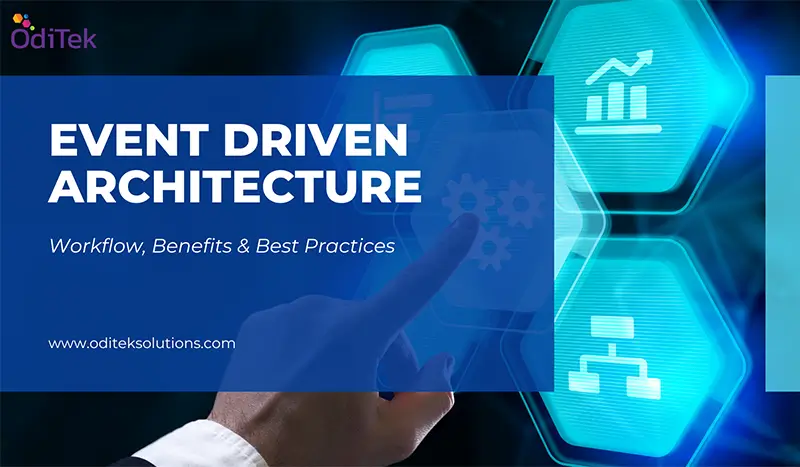In the ever-evolving landscape of modern technology, businesses constantly seek innovative ways to enhance efficiency and responsiveness. One such paradigm that has gained significant traction is Event-Driven Architecture (EDA). The core concepts of EDA workflow and explore how it enables the creation of integration solutions that respond to and process events in real-time, paving the way for instant data updates and with other Event-Driven Architecture best practices in a workflow process.
Understanding Event-Driven Architecture (EDA)
Event-driven architecture revolves around the idea of building systems that can react to events as they occur, rather than relying on traditional request-response models. Events, which can be anything from user actions and sensor outputs to system notifications, serve as the catalysts for triggering specific actions within the architecture.
EDA delves into outlines and Event-Driven Architecture best practices a comprehensive EDA workflow for developers and architects. These events could range from user interactions to system-generated notifications.
Event-Driven Architecture Best Practices
1. Decoupling and Loose Coupling
Decoupling components ensures that changes in one part of the system do not adversely affect others. Loose coupling enhances flexibility enables scaling, and maintenance, allowing for easier modifications and upgrades without causing disruptions across the architecture.
2. Reliable Event Delivery
Implement mechanisms for reliable event delivery. Technologies like Apache Kafka or RabbitMQ can be used to ensure that events are delivered in a reliable and fault-tolerant manner.
3. Monitoring and Logging
Implement robust monitoring and logging for events. This includes tracking event production, consumption, and handling failures. Tools like Prometheus and Grafana can be valuable for monitoring an EDA.
4. Identify Events
Understand the business domain and identify events that are meaningful within the context of your application. These could include user actions, system updates, or external triggers.
Key Components of EDA Workflow
At the heart of any successful implementation of EDA lies a well-defined and efficient EDA workflow. It is a structured process that ensures seamless communication and effective handling of data, enabling real-time responsiveness and adaptability. It is crucial for leveraging its event-driven Architecture benefits effectively. Here is a breakdown of the EDA workflow:
1. Event Generation of Sourcing
The EDA workflow is generated by various sources within the system. Events can be triggered by various sources such as user action on an interface, data updates from external sources, system activities, IoT devices, or any other noteworthy occurrence. The process of event sourcing involves capturing, logging, and storing these events in a structured format. Then categorized and structured for further processing.
2. Event Processing and Routing
Collected events undergo processing, transforming them for downstream services, and are then routed to specific destinations. Event routing distributes these events to relevant components or microservices through messaging systems like Kafka, RabbitMQ, or AWS SNS, ensuring reliable transmission across the architecture.
3. Triggering Actions
Beyond data updates, EDA empowers systems to automatically trigger actions in response to specific events. For instance, an e-commerce platform can instantly notify inventory systems of a new order, prompting them to update stock levels. This ability to automate actions based on events not only streamlines processes but also enhances the overall efficiency of the system.
4. Error Handling and Recovery
No system is immune to errors. An integral part of the EDA workflow involves implementing robust error-handling mechanisms and recovery strategies. This ensures the resilience of the architecture, minimizing downtime and maintaining a smooth user experience.
Event-Driven Architecture Benefits
1. Real-Time Responsiveness
The hallmark of Event-Driven Architecture lies in its ability to provide real-time responsiveness. Traditional architectures often rely on periodic checks or polling mechanisms to detect changes in the system. EDA, on the other hand, enables systems to instantly respond to events, ensuring that updates and actions are executed in near real-time.
2. Instant Data Updates
One of the key Event-Driven Architecture benefits is its capacity to facilitate instant data updates. As events occur, the relevant systems can update their data stores without delay, ensuring that information remains current and accurate. This is particularly crucial in scenarios where timely data is paramount, such as financial transactions, IoT applications, or collaborative platforms.
3. Building Integration Solutions
EDA’s core is the facilitation of seamless integration between disparate systems. Whether connecting legacy applications with modern cloud-based services or orchestrating a network of microservices, EDA allows for the creation of integration solutions that transcend the limitations of traditional architectures.
4. Scalability and Flexibility
EDA facilitates the creation of loosely coupled components, enabling easier scalability without impacting the entire system. As the system grows, new event producers and consumers can be added without affecting the existing components. This modularity and flexibility allow for the addition of new functionalities or changes and adapting to evolving business needs.
Challenges and Considerations
While Event-Driven Architecture offers numerous advantages, it is essential to acknowledge and address potential challenges. These may include ensuring event reliability, managing the complexity of event flows, and implementing effective error-handling mechanisms. A well-thought-out design and a robust event processing infrastructure are crucial to overcoming these challenges.
Conclusion
The demand for real-time responsiveness and seamless integration is higher than ever. Event-driven architecture emerges as a formidable solution, enabling the development of integration solutions that can keep up with the dynamic nature of modern business processes. By harnessing the power of events, businesses can achieve a level of agility and efficiency that was once thought to be out of reach. Embrace the future of integration with EDA workflow, and witness the transformation of your systems into agile, responsive, and event-ready environments.
At OdiTek, we understand the critical role of the EDA in today’s digital era. Our expertise in Event-Driven Architecture ensures that businesses can navigate this complex ground effectively.







